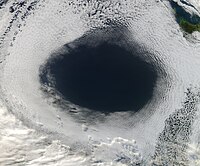
Photo from wikipedia
Abstract Deviations in South Asian Summer Monsoon (SASM) precipitation affect the regional floods and drought patterns. In the current study, in-situ observations from Pakistan Meteorological Department (PMD), remotely sensed precipitation… Click to show full abstract
Abstract Deviations in South Asian Summer Monsoon (SASM) precipitation affect the regional floods and drought patterns. In the current study, in-situ observations from Pakistan Meteorological Department (PMD), remotely sensed precipitation data from Climate Hazard Infrared Precipitation with Station data (CHIRPS), reanalysis data from ERA5, and National Center for Environmental Prediction/National Center for Atmospheric Research (NCEP/NCAR) during 1981–2018 are used to explore the atmospheric circulation patterns during above and below-normal precipitation episodes. In a statistical sense, two methods, namely the Empirical Orthogonal Function (EOF) and Percent Normal (PN) indices are used to derive dominant spatial patterns and temporal evolution of extreme monsoon precipitation episodes. Results inferred 60% of the variance to the leading EOF mode depicting a similar spatial pattern of eigenvectors across the region. The leading principal component (PC) and PN index together depicted similar deviations, complementing the extreme flooding and drought years. From the composites, an anomalous increase (decrease) in seasonal precipitation magnitude was observed. The possible mechanism suggests an active control of atmospheric and sea-surface temperature (SST) forcing by altering the wind ascent (descent). The jet streams (200 hPa) intensification of Rossby waves high (low) pressure provides favorable frontal boundaries between polar cold and tropical warm air masses. The westerlies and easterlies are intensified (suppressed) during the above (below) normal precipitation composites, affecting the moisture transport. The enhanced (reduced) convective activities in the Indian Ocean as a primary source affected precipitation in the region during each composite.
Journal Title: Atmospheric Research
Year Published: 2021
Link to full text (if available)
Share on Social Media: Sign Up to like & get
recommendations!